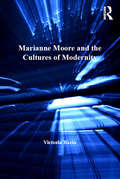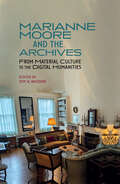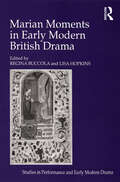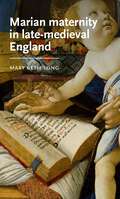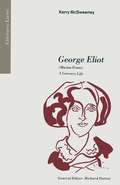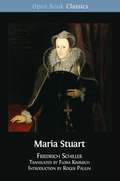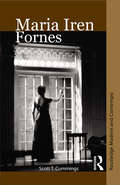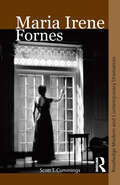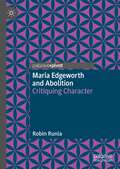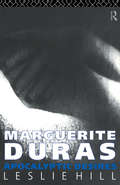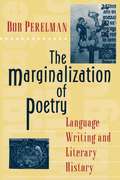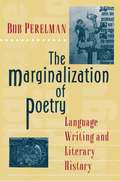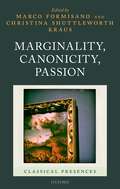- Table View
- List View
Marianne Moore and the Cultures of Modernity
by Victoria BazinVictoria Bazin examines the poetry of Marianne Moore as it is shaped by and responsive to the experience of being a modern woman, of living in the aftermath of the First World War, of being interpellated as a modern consumer and of writing in "the age of mechanical reproduction." She argues that Moore's textual collages and syllabic sculptures are based on the cultural clutter or debris of modernity, on textual extracts and reproductions, on the phantasmagoria of city life revealing something modernism worked hard to conceal: its relation to modernity, more specifically its relation to the new emerging and expanding mass consumer culture. Drawing extensively on archival resources to trace Moore's influences and to describe her own distinctive modernist aesthetic, this book argues that it was her feminist adaptation of pragmatism that shaped her poetic response to modernity. Moore's use of the quoted fragment is conceptualised in relation not only to Walter Benjamin's philosophical history but also to William James's image of the world as a series of "partial stories." As such, this account of Marianne Moore not only contributes to a greater understanding of the poet and her work, but it also offers up a more politicized and historically nuanced understanding of poetic modernism between the wars, one that retains a sense of the formal complexities of poetic language and the poet's own ethical imperatives whilst also recognising the material impact of modernity upon the modernist poem. This book will appeal, therefore, not only to scholars already familiar with Moore's poetry but more widely to those interested in modernism and American culture between the wars.
Marianne Moore and the Cultures of Modernity
by Victoria BazinVictoria Bazin examines the poetry of Marianne Moore as it is shaped by and responsive to the experience of being a modern woman, of living in the aftermath of the First World War, of being interpellated as a modern consumer and of writing in "the age of mechanical reproduction." She argues that Moore's textual collages and syllabic sculptures are based on the cultural clutter or debris of modernity, on textual extracts and reproductions, on the phantasmagoria of city life revealing something modernism worked hard to conceal: its relation to modernity, more specifically its relation to the new emerging and expanding mass consumer culture. Drawing extensively on archival resources to trace Moore's influences and to describe her own distinctive modernist aesthetic, this book argues that it was her feminist adaptation of pragmatism that shaped her poetic response to modernity. Moore's use of the quoted fragment is conceptualised in relation not only to Walter Benjamin's philosophical history but also to William James's image of the world as a series of "partial stories." As such, this account of Marianne Moore not only contributes to a greater understanding of the poet and her work, but it also offers up a more politicized and historically nuanced understanding of poetic modernism between the wars, one that retains a sense of the formal complexities of poetic language and the poet's own ethical imperatives whilst also recognising the material impact of modernity upon the modernist poem. This book will appeal, therefore, not only to scholars already familiar with Moore's poetry but more widely to those interested in modernism and American culture between the wars.
Marianne Moore and the Archives (Clemson University Press w/ LUP)
by Jeff W. WestoverThe essays that comprise Marianne Moore and the Archives: From Material Culture to the Digital Humanities use new archival research to explore the work of this major American modernist poet, providing innovative approaches to Moore’s career as it is documented in her archives. The volume represents new interpretations of archival materials found at the Rosenbach Museum and Library in Philadelphia, where Moore’s collection is held. This volume is also the first that draws upon the Marianne Moore Digital Archive (MMDA), a major project that is digitizing, transcribing, and annotating Moore’s notebooks for use by scholars, students, and non-academics to make these materials more widely accessible.
Marianne Moore and the Archives (Clemson University Press w/ LUP)
The essays that comprise Marianne Moore and the Archives: From Material Culture to the Digital Humanities use new archival research to explore the work of this major American modernist poet, providing innovative approaches to Moore’s career as it is documented in her archives. The volume represents new interpretations of archival materials found at the Rosenbach Museum and Library in Philadelphia, where Moore’s collection is held. This volume is also the first that draws upon the Marianne Moore Digital Archive (MMDA), a major project that is digitizing, transcribing, and annotating Moore’s notebooks for use by scholars, students, and non-academics to make these materials more widely accessible.
Marianne Moore and the Archives (Clemson University Press w/ LUP)
The essays that comprise Marianne Moore and the Archives: From Material Culture to the Digital Humanities use new archival research to explore the work of this major American modernist poet, providing innovative approaches to Moore’s career as it is documented in her archives. The volume represents new interpretations of archival materials found at the Rosenbach Museum and Library in Philadelphia, where Moore’s collection is held. This volume is also the first that draws upon the Marianne Moore Digital Archive (MMDA), a major project that is digitizing, transcribing, and annotating Moore’s notebooks for use by scholars, students, and non-academics to make these materials more widely accessible.
Marian Moments in Early Modern British Drama
by Lisa HopkinsConcerning itself with the complex interplay between iconoclasm against images of the Virgin Mary in post-Reformation England and stage representations that evoke various 'Marian moments' from the medieval, Catholic past, this collection answers the call for further investigation of the complex relationship between the fraught religio-political culture of the early modern period and the theater that it spawned. Joining historians in rejecting the received belief that Catholicism could be turned on and off like a water spigot in response to sixteenth-century religious reform, the early modern British theater scholars in this collection turn their attention to the vestiges of Catholic tradition and culture that leak out in stage imagery, plot devices, and characterization in ways that are not always clearly engaged in the business of Protestant panegyric or polemic. Among the questions they address are: What is the cultural function of dramatic Marian moments? Are Marian moments nostalgic for, or critical of, the 'Old Faith'? How do Marian moments negotiate the cultural trauma of iconoclasm and/or the Reformation in early modern England? Did these stage pictures of Mary provide subversive touchstones for the Old Faith of particular import to crypto-Catholic or recusant members of the audience?
Marian Moments in Early Modern British Drama
by Lisa HopkinsConcerning itself with the complex interplay between iconoclasm against images of the Virgin Mary in post-Reformation England and stage representations that evoke various 'Marian moments' from the medieval, Catholic past, this collection answers the call for further investigation of the complex relationship between the fraught religio-political culture of the early modern period and the theater that it spawned. Joining historians in rejecting the received belief that Catholicism could be turned on and off like a water spigot in response to sixteenth-century religious reform, the early modern British theater scholars in this collection turn their attention to the vestiges of Catholic tradition and culture that leak out in stage imagery, plot devices, and characterization in ways that are not always clearly engaged in the business of Protestant panegyric or polemic. Among the questions they address are: What is the cultural function of dramatic Marian moments? Are Marian moments nostalgic for, or critical of, the 'Old Faith'? How do Marian moments negotiate the cultural trauma of iconoclasm and/or the Reformation in early modern England? Did these stage pictures of Mary provide subversive touchstones for the Old Faith of particular import to crypto-Catholic or recusant members of the audience?
Marian maternity in late-medieval England (Manchester Medieval Literature and Culture)
by Mary Beth LongMarian maternity in late-medieval England takes advantage of the fifteenth century’s intense interest in the Virgin Mary, the best-documented mother of the medieval period, to examine the constructions and performances of maternity in vernacular religious texts. By bringing together texts and authors that are not often discussed in tandem, this study offers a rich examination of the multiple factors at play as Marian material circulated among experienced devotional readers. Taking a close look at the private devotional reading of late-medieval patrons, the book shows how texts including Chaucer’s poetry, Margery Kempe’s Boke, and legendaries of female saints are saturated with indirect references to and imitations of the Virgin. Marian maternity in late-medieval England employs a matricentric feminist approach to discern how readers’ devotional literacies inform their understanding and imitation of the Virgin’s maternal practice. Attending to internal cues in the texts, to manuscript contexts, and to the evidence and content of readers’ multiple literacies, the author examines Marian maternity as both theological concept and imitable practice. The result is a book that explains late-medieval perceptions of Mary’s maternity and sets them against readers’ devotional, emotional and relational circumstances.
Marian maternity in late-medieval England (Manchester Medieval Literature and Culture)
by Mary Beth LongMarian maternity in late-medieval England takes advantage of the fifteenth century’s intense interest in the Virgin Mary, the best-documented mother of the medieval period, to examine the constructions and performances of maternity in vernacular religious texts. By bringing together texts and authors that are not often discussed in tandem, this study offers a rich examination of the multiple factors at play as Marian material circulated among experienced devotional readers. Taking a close look at the private devotional reading of late-medieval patrons, the book shows how texts including Chaucer’s poetry, Margery Kempe’s Boke, and legendaries of female saints are saturated with indirect references to and imitations of the Virgin. Marian maternity in late-medieval England employs a matricentric feminist approach to discern how readers’ devotional literacies inform their understanding and imitation of the Virgin’s maternal practice. Attending to internal cues in the texts, to manuscript contexts, and to the evidence and content of readers’ multiple literacies, the author examines Marian maternity as both theological concept and imitable practice. The result is a book that explains late-medieval perceptions of Mary’s maternity and sets them against readers’ devotional, emotional and relational circumstances.
Maria Stuart (Open Book Classics #12)
by Friedrich Schiller. Translated by Flora Kimmich. With an Introduction by Roger PaulinMaria Stuart, described as Schiller’s most perfect play, is a finely balanced, inventive account of the last day of the captive Queen of Scotland, caught up in a great contest for the throne of England after the death of Henry VIII and over the question of England’s religious confession. Hope for and doubt about Mary’s deliverance grow in the first two acts, given to the Scottish and the English queen respectively, reach crisis at the center of the play, where the two queens meet in a famous scene in a castle park, and die away in acts four and five, as the action advances to its inevitable end. The play is at once classical tragedy of great fineness, costume drama of the highest order—a spectacle on the stage—and one of the great moments in the long tradition of classical rhetoric, as Elizabeth’s ministers argue for and against execution of a royal prisoner. Flora Kimmich’s new translation carefully preserves the spirit of the original: the pathos and passion of Mary in captivity, the high seriousness of Elizabeth’s ministers in council, and the robust comedy of that queen’s untidy private life. Notes to the text identify the many historical figures who appear in the text, describe the political setting of the action, and draw attention to the structure of the play. Roger Paulin’s introduction discusses the many threads of the conflict in Maria Stuart and enriches our understanding of this much-loved, much-produced play. Maria Stuart is the last of a series of five new translations of Schiller’s major plays, accompanied by notes to the text and an authoritative introduction.
Maria Irene Fornes (Routledge Modern and Contemporary Dramatists)
by Scott T. CummingsMaria Irene Fornes is the most influential female American dramatist of the 20th century. That is the argument of this important new study, the first to assess Fornes's complete body of work. Scott T. Cummings considers comic sketches, opera libretti and unpublished pieces, as well as her best-known plays, in order to trace the evolution of her dramaturgy from the whimsical Off-Off Broadway plays of the 1960s to the sober, meditative work of the 1990s. The book also reflects on her practice as an inspirational teacher of playwriting and the primary director of her own plays. Drawing on the latest scholarship and his own personal research and interviews with Fornes over two decades, Cummings examines Fornes's unique significance and outlines strategies for understanding her fragmentary, enigmatic, highly demanding theater.
Maria Irene Fornes (Routledge Modern and Contemporary Dramatists)
by Scott T. CummingsMaria Irene Fornes is the most influential female American dramatist of the 20th century. That is the argument of this important new study, the first to assess Fornes's complete body of work. Scott T. Cummings considers comic sketches, opera libretti and unpublished pieces, as well as her best-known plays, in order to trace the evolution of her dramaturgy from the whimsical Off-Off Broadway plays of the 1960s to the sober, meditative work of the 1990s. The book also reflects on her practice as an inspirational teacher of playwriting and the primary director of her own plays. Drawing on the latest scholarship and his own personal research and interviews with Fornes over two decades, Cummings examines Fornes's unique significance and outlines strategies for understanding her fragmentary, enigmatic, highly demanding theater.
Maria Edgeworth's Irish Writing: Language, History, Politics
by B. HollingworthEdgeworth is regarded as a pioneer in the development of the regional novel and the use of vernacular language. This study investigates her attitudes towards language and regionalism. It shows, by a detailed discussion of her major Irish texts - Castle Rackrent , Essay on Irish Bulls , Ennui , The Absentee and Ormond - how her intellectual 'Lunar' background, and her life in Ireland during the momentous years of the Union is reflected in the form and language of her writing.
Maria Edgeworth and Abolition: Critiquing Character
by Robin RuniaThis Palgrave Pivot offers new readings of Maria Edgeworth’s representations of slavery. It shows how Edgeworth employed satiric technique and intertextual allusion to represent discourses of slavery and abolition as a litmus test of character – one that she invites readers to use on themselves. Over the course of her career, Edgeworth repeatedly indicted hypocritical and hyperbolic misappropriation of the sentimental rhetoric that dominated the slavery debate. This book offers new readings of canonical Edgeworth texts as well as of largely neglected works, including: Whim for Whim, “The Good Aunt”, Belinda, “The Grateful Negro”, “The Two Guardians”, and Harry and Lucy Continued. It also offers an unprecedented deep-dive into an important Romantic Era woman writer’s engagement with discourses of slavery and abolition.
Maria Cross: Imaginative Patterns in a Group of Catholic Writers
by Conor Cruise O'BrienThe first literary phase in the brilliant and protean career of Conor Cruise O'Brien was his work as critic for Dublin literary magazine The Bell, which begat this collection of essays first published in 1952 (under the pseudonym 'Donat O'Donnell', as O'Brien was then a working civil servant.) In it, O'Brien set himself to a study of 'the patterns of several exceptionally vivid imaginations which are permeated by Catholicism' - from Graham Greene and Evelyn Waugh to Francois Mauriac and Paul Claudel - and to analyse 'what those patterns might share'. The originality and flair of Maria Cross won O'Brien many vocal admirers, among them Dag Hammarskjold, cerebral Secretary-General of the United Nations.'A most interesting and at times brilliant book, admirably and wittily written.'New Statesman'One of the most acute and stimulating books of literary criticism to be published for some years.' Spectator
Marguerite Duras: Apocalyptic Desires
by Leslie HillMarguerite Duras is France's best-known and most controversial contemporary woman writer. Duras' influence extends from her early novels of the 1950's to her radically innovative experimental autobiographical text of the 1980's The Lover Leslie Hill's book throws new light on Duras' relationship to feminism, psychoanalysis, sexuality, literature, film, politics, and the media. Feted by Kristeva, and Laca who claimed her as almost his other self, Duras is revealed to be a profoundly transgressive thinker and artist. It will be a must for all concerned with contemporary writing, writing by women, recent European cinema, film and literature.
Marguerite Duras: Apocalyptic Desires
by Leslie HillMarguerite Duras is France's best-known and most controversial contemporary woman writer. Duras' influence extends from her early novels of the 1950's to her radically innovative experimental autobiographical text of the 1980's The Lover Leslie Hill's book throws new light on Duras' relationship to feminism, psychoanalysis, sexuality, literature, film, politics, and the media. Feted by Kristeva, and Laca who claimed her as almost his other self, Duras is revealed to be a profoundly transgressive thinker and artist. It will be a must for all concerned with contemporary writing, writing by women, recent European cinema, film and literature.
Marguerite de Navarre's Shifting Gaze: Perspectives on gender, class, and politics in the Heptaméron (Women and Gender in the Early Modern World)
by Elizabeth Chesney ZeguraMarguerite de Navarre’s Heptaméron, composed in the 1540s and first published posthumously in 1558 and 1559, has long been an interpretive puzzle. De Navarre (1492-1549), sister of King Francis I of France, was a controversial figure in her lifetime. Her evangelical activities and proximity to the Crown placed her at the epicenter of her country’s internecine strife and societal unrest. Yet her short stories appear to offer few traces of the sociopolitical turbulence that surrounded her.In Marguerite de Navarre’s Shifting Gaze, however, Elizabeth Zegura argues that the Heptaméron’s innocuous appearance camouflages its serious insights into patriarchy and gender, social class, and early modern French politics, which emerge from an analysis of the text’s shifting perspectives. Zegura’s approach, which focuses on visual cues and alternative standpoints and viewing positions within the text, hinges upon foregrounding "les choses basses" (lowly things) to which the devisante (storyteller) Oisille draws our attention in nouvelle (novella) 2 of the Heptaméron, using this downward, archaeological gaze to excavate layers of the text that merit more extensive critical attention.While her conclusions cast a new light on the literature, life, and times of Marguerite de Navarre, they are nevertheless closely aligned with recent scholarship on this important historical and literary figure.
Marguerite de Navarre's Shifting Gaze: Perspectives on gender, class, and politics in the Heptaméron (Women and Gender in the Early Modern World)
by Elizabeth Chesney ZeguraMarguerite de Navarre’s Heptaméron, composed in the 1540s and first published posthumously in 1558 and 1559, has long been an interpretive puzzle. De Navarre (1492-1549), sister of King Francis I of France, was a controversial figure in her lifetime. Her evangelical activities and proximity to the Crown placed her at the epicenter of her country’s internecine strife and societal unrest. Yet her short stories appear to offer few traces of the sociopolitical turbulence that surrounded her.In Marguerite de Navarre’s Shifting Gaze, however, Elizabeth Zegura argues that the Heptaméron’s innocuous appearance camouflages its serious insights into patriarchy and gender, social class, and early modern French politics, which emerge from an analysis of the text’s shifting perspectives. Zegura’s approach, which focuses on visual cues and alternative standpoints and viewing positions within the text, hinges upon foregrounding "les choses basses" (lowly things) to which the devisante (storyteller) Oisille draws our attention in nouvelle (novella) 2 of the Heptaméron, using this downward, archaeological gaze to excavate layers of the text that merit more extensive critical attention.While her conclusions cast a new light on the literature, life, and times of Marguerite de Navarre, they are nevertheless closely aligned with recent scholarship on this important historical and literary figure.
The Marginalization of Poetry: Language Writing and Literary History
by Bob PerelmanLanguage writing, the most controversial avant-garde movement in contemporary American poetry, appeals strongly to writers and readers interested in the politics of postmodernism and in iconoclastic poetic form. Drawing on materials from popular culture, avoiding the standard stylistic indications of poetic lyricism, and using nonsequential sentences are some of the ways in which language writers make poetry a more open and participatory process for the readers. Reading this kind of writing, however, may not come easily in a culture where poetry is treated as property of a special class. It is this barrier that Bob Perelman seeks to break down in this fascinating and comprehensive account of the language writing movement. A leading language writer himself, Perelman offers insights into the history of the movement and discusses the political and theoretical implications of the writing. He provides detailed readings of work by Lyn Hejinian, Ron Silliman, and Charles Bernstein, among many others, and compares it to a wide range of other contemporary and modern American poetry. A variety of issues are addressed in the following chapters: "The Marginalization of Poetry," "Language Writing and Literary History," "Here and Now on Paper," "Parataxis and Narrative: The New Sentence in Theory and Practice," "Write the Power," "Building a More Powerful Vocabulary: Bruce Andrews and the World (Trade Center)," "This Page Is My Page, This Page Is Your Page: Gender and Mapping," "An Alphabet of Literary Criticism," and "A False Account of Talking with Frank O'Hara and Roland Barthes in Philadelphia."
The Marginalization of Poetry: Language Writing and Literary History
by Bob PerelmanLanguage writing, the most controversial avant-garde movement in contemporary American poetry, appeals strongly to writers and readers interested in the politics of postmodernism and in iconoclastic poetic form. Drawing on materials from popular culture, avoiding the standard stylistic indications of poetic lyricism, and using nonsequential sentences are some of the ways in which language writers make poetry a more open and participatory process for the readers. Reading this kind of writing, however, may not come easily in a culture where poetry is treated as property of a special class. It is this barrier that Bob Perelman seeks to break down in this fascinating and comprehensive account of the language writing movement. A leading language writer himself, Perelman offers insights into the history of the movement and discusses the political and theoretical implications of the writing. He provides detailed readings of work by Lyn Hejinian, Ron Silliman, and Charles Bernstein, among many others, and compares it to a wide range of other contemporary and modern American poetry. A variety of issues are addressed in the following chapters: "The Marginalization of Poetry," "Language Writing and Literary History," "Here and Now on Paper," "Parataxis and Narrative: The New Sentence in Theory and Practice," "Write the Power," "Building a More Powerful Vocabulary: Bruce Andrews and the World (Trade Center)," "This Page Is My Page, This Page Is Your Page: Gender and Mapping," "An Alphabet of Literary Criticism," and "A False Account of Talking with Frank O'Hara and Roland Barthes in Philadelphia."
Marginality in the Contemporary British Novel (Continuum Literary Studies)
by Nicola AllenThe 'Marginal' as a concept has become an integral part of the British novel as it stands at the turn of the century. Both popular and literary fiction since the mid-1970s has seen an increasing emphasis on the marginal subject. This study offers readings of a wide range of contemporary British novels that represent characters or communities at the margin of society. Nicola Allen analyses three conceptual categories representing the marginal subject in the contemporary British novel: the character of the misfit or outsider; the emergence of the grotesque; and the rediscovery of previously marginalized narratives such as myth and fantasy. This innovative and original monograph focuses on the contention that the contemporary novel of marginality conveys a belief in the socially transformative powers of narrative, and suggests that narrative has played a central role in bringing marginal politics and marginal issues to the fore in contemporary Britain.
Marginality in the Contemporary British Novel (Continuum Literary Studies)
by Nicola AllenThe 'Marginal' as a concept has become an integral part of the British novel as it stands at the turn of the century. Both popular and literary fiction since the mid-1970s has seen an increasing emphasis on the marginal subject. This study offers readings of a wide range of contemporary British novels that represent characters or communities at the margin of society. Nicola Allen analyses three conceptual categories representing the marginal subject in the contemporary British novel: the character of the misfit or outsider; the emergence of the grotesque; and the rediscovery of previously marginalized narratives such as myth and fantasy. This innovative and original monograph focuses on the contention that the contemporary novel of marginality conveys a belief in the socially transformative powers of narrative, and suggests that narrative has played a central role in bringing marginal politics and marginal issues to the fore in contemporary Britain.
Marginality, Canonicity, Passion (Classical Presences)
by Marco Formisano Christina Shuttleworth KrausIn recent years, the discipline of Classics has been experiencing a profound transformation affecting not only its methodologies and hermeneutic practices - how classicists read and interpret ancient literature - but also, and more importantly, the objects of classical study themselves. One of the most important factors has been the establishment of reception studies, examining the ways in which classical literature and culture have been appropriated or responded to in later ages and/or non-western cultures. This temporal and cultural expansion beyond the 'traditional' remit of the field has had many salutary effects, but reception studies are not without limitations: of particular consequence is a tendency to focus almost exclusively on the most canonical Greek and Latin texts which is partly due to the sheer scale on which they have been received, adapted, discussed, and alluded to since antiquity. By definition, reception studies are uninterested in texts which have had no 'success', but the result of an implicit adoption of canonicity as an unspoken criterion is the marginalization of other texts which, despite their inherent value, have not experienced so significant a Nachleben. This volume seeks to move beyond the questions of what is central, what is marginal, and why, to explore instead the range and significance of the classical canon and the processes by which it is shaped and changed by its reception in different academic and cultural environments. By examining the academic study of Classics from the interrelated titular perspectives of marginality, canonicity, and passion, it aims to unveil their many subtle implications and reopen a discussion not only about what makes the discipline unique, but also about what direction it might take in the future.
